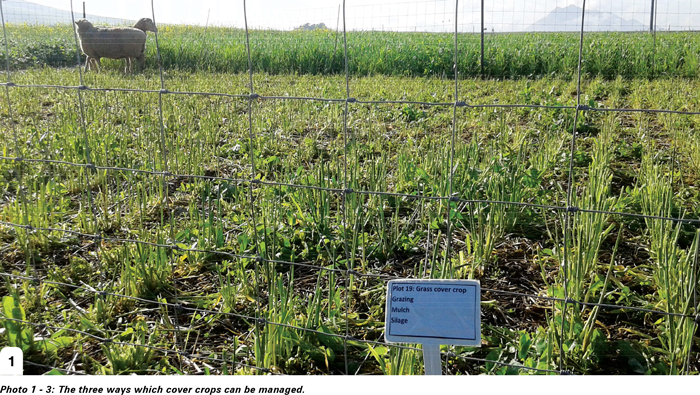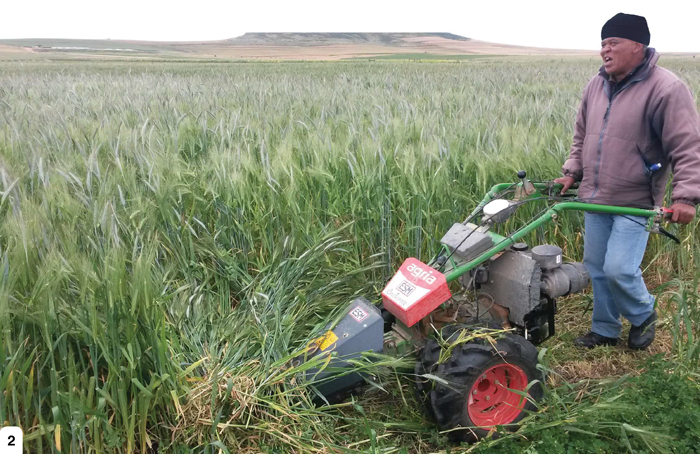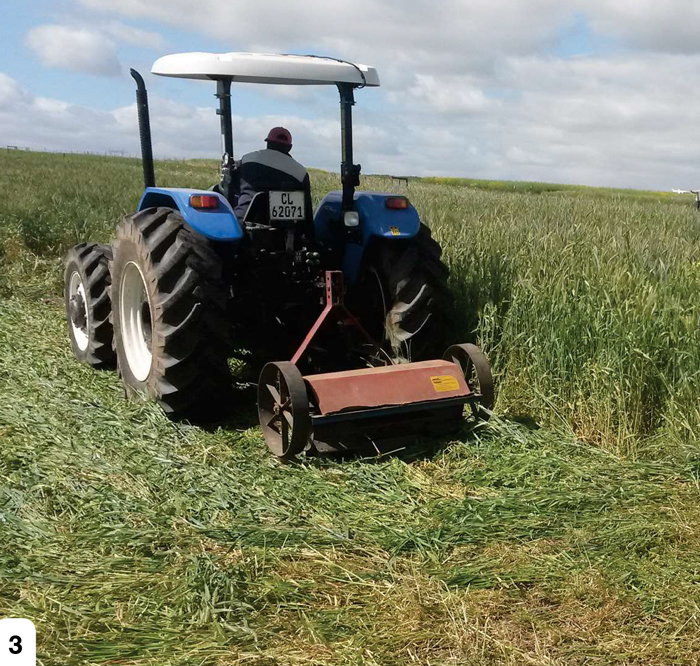September 2019
| Dr Johann Strauss, Directorate Plant Sciences, Research and Technology Development Western Cape Department of Agriculture. Send an email to johannst@elsenburg.com |
 |
Cover crops can play a vital role in improving our current cropping systems and open new avenues to not only improve the biodiversity within our systems, but also offer new grazing opportunities.
BACKGROUND
It is important to know that soil is not only a medium that keeps plants upright, but a living breathing system that consists of chemical, physical and biological properties. The beauty of cover crops is that it can affect all three of these areas. The choice of crops for a cover crop mixture can help alleviate compaction without falling back on the plough. Single plant type cover crops can help suppress weeds. A good example is Saia oats. If the mixture is high in cereal crop content it can provide excellent cover of the soil during the long hot months and thus protect the soil from the harsh sun. The choice of crops in the mixture can also help to make certain nutrients that was locked into the soil more available to the next crop, which can lower the need for fertiliser in the following year. Including legumes in the cover crop can provide free nitrogen for the following crop.
There are three management options for your cover crops namely, mulching, haying or grazing. Each has advantages and disadvantages. In a study at Langgewens Research Farm it was shown that grazing and mulching the cover crop is more beneficial than haying the cover crop. More nutrients were available in the soil and left on top of the soil in the residue than where the cover crop was hayed. Nutritional analysis also showed that a multispecies cover crop can deliver a more balanced diet to animals, which might also have an effect on lowering the cost of supplemental feed.
MANAGEMENT OF THE COVER CROP
Unfortunately cover crop seed can be expensive and therefore the aim in managing the cover crop is to keep other input costs to a minimum, or nothing at all. In our research we plant the cover crop with no fertiliser at all, but one can add a little bit of fertiliser (less than 10 kg of nitrogen per ha) to serve as a kick start. We do not spray herbicides, insecticides or fungicides during the season. In September we terminate the cover crop to ensure than nothing set seed.

Terminating a cover crop used as mulch
The choice of crops that make up the mixture will also play a role in your choice of the method you use to terminate the cover crop. If there are more cereal crop seed in the mixture, the easier it is to terminate with a crimping roller alone. If there is however a larger number of legumes such as vetch and clovers in the mixture, the crimping roller alone might not be as effective and then one can also add a contact herbicide application following the roller.

Terminating a cover crop used as hay
When using the cover crop as a hay crop it is important to cut the crop before seed set occurs. It ensures that we do not have a carryover of seed that can act as a weed in the following crop. Regrowth of plants following the haymaking process will not be vigorous enough to warrant the use of a crimping roller. In this case a contact herbicide will be more appropriate. Usually this option of cover crop use leaves very little cover on top of the soil at the end of the season. Cutting the hay, a little bit higher might solve this problem.
Terminating following grazing
The idea behind grazing cover crops is to recuperate some of the money invested in the planting of the cover crop by producing meat or milk. Depending on the climatic conditions in the season, a cover crop can be grazed more than once. The number of grazing opportunities will depend on the amount of regrowth that occurs. Larger number of animals for short periods of time is ideal. If you want to maximise your growth of the cover crop in the grazing system, a low topdressing might work well to enhance regrowth. Remember the ideal is to keep as much material left at the end of the season on top of the soil to protect it from the climate. Any regrowth at the end of the season can be terminated with a crimping roller or contact herbicide.

CONCLUSION
Cover crops can open new opportunities to farmers in a number of ways. We are currently working on a cover crop calculator to help with the crop type percentages within a cover crop mixture. Added to this will be a function to play around with the available species to make the cover crop as affordable as possible.
Publication: September 2019
Section: Pula/Imvula